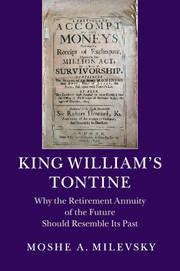Book contents
- Frontmatter
- Epigraph
- Contents
- Preface: In Memoriam for Jared
- Acknowledgments
- 1 King Billy, Protestant Hero of england
- 2 Tontine's Economic Origins: Cheaper Debt
- 3 A Most Curious Will(iam) and Older Than You Think
- 4 The Million Act to Fight a War against France
- 5 Don't Englishmen Die? Anti-Selection vs. Fraud
- 6 Is Your Tontine a Stock or a Bond?
- 7 Optimal Tontine: Hedging (Some) Longevity Risk
- 8 Conclusion: Tontines for the Twenty-First Century
- Epilogue: What Did William Really Know?
- Appendix A The List of Nominees
- Appendix B The Gompertz-Makeham Law of Mortality
- Appendix C 14% for One, 12% for Two, or 10% for Three?
- Source Notes and Guide to Further Reading
- References
- Index
2 - Tontine's Economic Origins: Cheaper Debt
Published online by Cambridge University Press: 05 May 2015
- Frontmatter
- Epigraph
- Contents
- Preface: In Memoriam for Jared
- Acknowledgments
- 1 King Billy, Protestant Hero of england
- 2 Tontine's Economic Origins: Cheaper Debt
- 3 A Most Curious Will(iam) and Older Than You Think
- 4 The Million Act to Fight a War against France
- 5 Don't Englishmen Die? Anti-Selection vs. Fraud
- 6 Is Your Tontine a Stock or a Bond?
- 7 Optimal Tontine: Hedging (Some) Longevity Risk
- 8 Conclusion: Tontines for the Twenty-First Century
- Epilogue: What Did William Really Know?
- Appendix A The List of Nominees
- Appendix B The Gompertz-Makeham Law of Mortality
- Appendix C 14% for One, 12% for Two, or 10% for Three?
- Source Notes and Guide to Further Reading
- References
- Index
Summary
THE FINANCIAL PATH TO LONG-TERM BORROWING
To properly appreciate tontines and the rationale for their existence, one needs to understand the process by which monarchs borrowed money prior to the modern era. Imagine for a moment that you are the king of England sometime during the seventeenth century and that you need £1 million rather urgently, to build some boats, or perhaps wage a war against a mortal enemy or to support your many (illegitimate) children. Now, being that the Middle Ages are over and the Divine Rights of Kings is no longer in fashion, you can't just pilfer the money from your loyal subjects. Sure, you might be able to tax your citizens – which is a far more palatable form of confiscation – but that process takes time to implement and it certainly won't generate the million pounds very quickly. Like anyone who has needed large sums of money in a hurry, you really have no choice but to borrow the money.
Now – whether you are a seventeenth-century king or a twenty-first-century commoner – there are essentially three methods by which to structure such a loan and eventually pay back your creditors:
You repay the principal you borrowed plus the interest accrued, all at the very end of the term of the loan in one big bullet payment.
You make periodic interests payment on the loan and then return or payback the original principal at the very end.
You use the common method used to finance your home and car, which is you make relatively constant payments that blend interest and principal over time, so that the entire loan is paid off by the very end. This is known as amortizing the loan.
As you might discern, method number one – pay all the interest and principal at the very end – isn't very appealing or practical. Eventually, when the loan term is over and it is time to pay it all back, you will have an even bigger “problem” than you do today.
- Type
- Chapter
- Information
- King William's TontineWhy the Retirement Annuity of the Future Should Resemble its Past, pp. 20 - 36Publisher: Cambridge University PressPrint publication year: 2015



